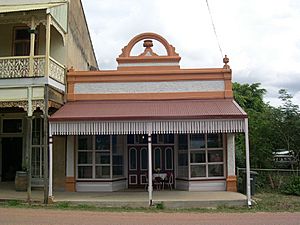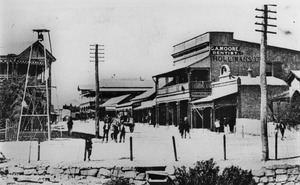Shop adjacent to Thorps Building facts for kids
Quick facts for kids Shop adjacent to Thorps Building |
|
|---|---|

Shop adjacent to Thorps Building, 2006
|
|
| Location | Macrossan Street, Ravenswood, Charters Towers Region, Queensland, Australia |
| Design period | 1900 - 1914 (early 20th century) |
| Built | c. 1901 |
| Official name: Shop adjacent to Thorps Building | |
| Type | state heritage (built) |
| Designated | 21 October 1992 |
| Reference no. | 600454 |
| Significant period | 1900s (fabric) c. 1901-1980s (historical use) |
| Lua error in Module:Location_map at line 420: attempt to index field 'wikibase' (a nil value). | |
The Shop adjacent to Thorps Building is a special old shop located on Macrossan Street in Ravenswood, Australia. It was built around 1901. This building is important because it tells a story about the history of Ravenswood. It is now listed on the Queensland Heritage Register, which means it is protected for future generations to see.
Contents
The Shop's Story: A Glimpse into Ravenswood's Past
This shop is right next to another historic building called Thorps Building. It's a single-story brick building that used to hold two different shops. It was likely built when Ravenswood was booming in the early 1900s. Over the years, it has been home to many businesses, including a popular bookseller, newsagent, and tobacco shop for a long time.
Ravenswood: A Gold Mining Town's Rise and Fall
Ravenswood was once a very important gold mining town in North Queensland. Finding gold helped decide where railways would go and where towns would be built. Some gold towns appeared quickly and then disappeared, but Ravenswood became a proper town with buildings and homes.
Gold was first found in Ravenswood in 1868. Soon after, mills were built to process the gold. The town was officially recognized in 1871. However, miners soon faced problems because the gold was hard to get out of the rock. Many miners left for other goldfields, like Charters Towers, which grew much faster.
How Ravenswood Kept Going
Even with the challenges, Ravenswood continued to do well. Gold was still being mined, and silver was found nearby in Totley in 1878. The town also became a busy trading center. By 1874, Ravenswood had important public buildings like a courthouse, police station, post office, and school. The arrival of the railway in 1884 also helped the town stay strong.
The Shop's Early Owners
The land where the shop stands was first owned by Phillip Benjamin in 1881. He quickly sold it to John Ellis, who made boots and saddles. Since this area was already a business hub, there might have been a shop there already, or Ellis might have built one. Later, in 1896, William J McChesney bought the property.
A Golden Boom and Decline
Around 1899, a new company called the New Ravenswood Company started up. They brought in new money and modern ways to mine gold. This made Ravenswood very rich for a few years. The shop's style and materials suggest it was built during this time of great prosperity. After a big fire in 1901, many buildings nearby were rebuilt with fancy brick, showing how wealthy the town was.
Sadly, this boom didn't last. After 1908, the town started to decline. Mining became too expensive, and the gold was harder to find. In 1912, Raymond W. Richards, who had been a bookseller and newsagent since 1902, bought the shop. As the town faded, many timber buildings were moved away. Brick buildings, like this shop and Thorps Building, had to stay.
The Shop Through the Years
In 1925, Phillip Dennis bought the shop. He opened a haberdashery (a shop selling sewing items), drapery (fabric), tobacconist, and newsagency. He might have even run two shops in the building.
Ravenswood continued to shrink. In 1930, it lost its railway connection, becoming the first Queensland town to do so. By the 1960s, only about 70 people lived there. However, tourists began to discover the town's history. People started working to protect its old buildings. The Dennis family owned the shop until 1984, when the current owners bought it.
Even though the shop has had many different businesses, it was a newsagent, tobacconist, and haberdashery for a long time. Today, it is empty. In the 1980s, the entire town of Ravenswood was recognized for its heritage. New mining started in 1987, but the town's historic charm remains.
What the Shop Looks Like
The shop is on Macrossan Street, right next to Thorps Building. This area was once the busy center of Ravenswood. The surrounding landscape still shows signs of mining, with old ruins and piles of dirt from digging.
It's a single-story building made of brick. It has two shopfronts with large glass display windows and a main entrance in the middle with wooden doors. The roof is sloped and covered with corrugated iron. You can't see the roof from the front because of a fancy brick wall called a parapet. This parapet has a raised part in the middle with an urn (a decorative vase) inside an arch. This design is similar to other important buildings in town, like the Imperial Hotel. There were also urns at each end of the parapet, but one is now missing.
A covered walkway, called an awning, stretches over the footpath in front of the shop. It's held up by simple wooden posts and has a decorative wooden border called a valance. Most of the original details of the shop are still there.
Why This Shop is Special
The Shop adjacent to Thorps Building was added to the Queensland Heritage Register on 21 October 1992. This means it's considered very important for a few reasons:
Showing Queensland's History
Ravenswood was one of the first major gold mining areas in North Queensland. Gold mining helped the region grow a lot. This shop, as a strong business building in a rich mining town, shows how Ravenswood developed during that time.
A Great Example of Old Shops
This shop is one of only two large retail stores left from what was once a busy commercial street in the early 1900s. It's a good example of a well-built commercial building from that era, showing how shops were designed and decorated back then.
Its Beautiful Look
Together with Thorps Building, this shop creates a beautiful and important part of the Ravenswood town view. It adds to the unique look and feel of the historic town.


